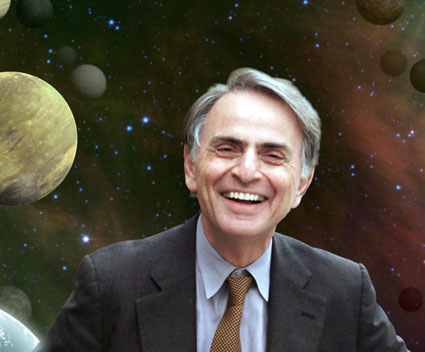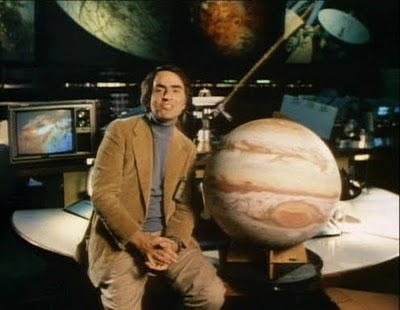Carl Sagan
By: Saqlain Golandaz
Personal Life
Carl Edward Sagan was born in Brooklyn, NY on November 9th, 1934. Sagan's interest and love for the Cosmos grew early when his mother used to bring books from the library for him to read. He graduated high school at the age of 16 and attended the University of Chicago for his undergraduate studies. He graduated with a BA in Physics and continued to achieve his Masters at UChicago as well. After earning his PhD in Astronomy and Astrophysics from the University of California, Berkeley, he helped a team there develop an infrared radiometer for NASA's Mariner 2 probe.
Marriage and Family Life
During his lifetime, Sagan had 3 different marriages, with Lynn Margulis (1957), Linda Salzmann (1968), and Ann Druyan (1981). He had a total of 5 children. One of his children, Nick Sagan, is currently a Science Fiction writer, involved in numerous well-known TV shows like Star Trek: Next Generation. Nick was inspired by both astrophysics and writing as he was exposed to both areas by his parents, Carl and Linda Salzmann.
When it came to religion, Sagan didn't associate himself with one, but he also didn't consider himself an atheist. In an interview in Ontario in 1996, he stated, "I am not an atheist. An atheist is someone who has compelling evidence that there is no Judeo-Christian-Islamic God. I am not that wise, but neither do I consider there to be anything approaching adequate evidence for such a god." His children followed in his footsteps and also don't associate themselves with any religion.
Death
Sagan died of pneumonia and complications from myelodysplasia on December 26th, 1996, at the age of 62.
Scientific Career and Work
Carl Sagan is known to have made substantial impact both in and out of the scientific circle. Not only did he answer previously-unanswerable questions about planets and the cosmos, but also got non-scientists and everyday people involved in learning about space. Sagan helped solve mysteries of high temperatures on Venus, the seasonal changes on Mars (windblown dust), and the physics of intergalactic interactions. During the 1950s, he briefed NASA astronauts before the Apollo missions, and was an experimenter for the Mariner, Viking, Voyager, and Galileo expeditions to the planets. Sagan was well-known to have a wide imagination, asking questions that humans didn't have the answer to then, and those that encouraged future expeditions and research. He was also a very confident man who was made to be on television. Having his own TV series, he broke down the study of space for laymen and involved everyone on Earth rather than the few that understood the complex science behind it. His passion to share his knowledge on astronomy and astrophysics increased curiosity and was known by NASA to be a facilitator in the "Golden Age" that spanned 30 productive and fast-growing years in Science, from 1960 to roughly 1990. He was rightly nicknamed "the astronomer of the people."
Venus
In the 1950s, little was known about the planet Venus. In the hopes of learning more about Earth and other planets compared to it, astronomers and biologists all over the world were trying to study Venus' atmosphere and environment in relation to its distance from the Sun. Specifically, they wanted to learn more about the radiation and different pressures, both on the surface and in the atmosphere of Venus. Previous scientists had hypothesized that Venus was a greenhouse gas furnace just because of how close it was to the Sun, but nobody was able to prove it with evidence. In 1960, Sagan, who was then a doctoral student, took data from tables designed for Steam boiler engineering and confirmed the hypothesis that Venus' atmosphere was due to the greenhouse effect, and the erratic movement of carbon dioxide molecules in the environment. He also pointed to absorption of radiation by water vapor as another likely culprit of the insane level of the greenhouse effect on Venus.
Climate Change
Through his studies on the environments on other planets in the Solar System, Sagan began to become very involved in the climate change conversation. He published multiple books about the weather in Jupiter, the environment on other planets, and the similarities between the biology and physics between the Earth and other planets in our Solar System. In excerpts from his bestselling book, Cosmos, Sagan states:
- On Venus, on Earth and elsewhere in the solar system, there is evidence for catastrophic destruction...There are mighty weather systems on the Earth—and in the high atmosphere of Venus and on Jupiter. There are sandstorms on the Earth and on Mars; lightning on Jupiter and Venus and Earth...On Mars, and elsewhere in the solar system, we see features that could not be produced today, landscapes carved hundreds of millions or billions of years ago when the planetary climate was probably very different. There is an additional factor that can alter the landscape and the climate of Earth: intelligent life, able to make major environmental changes. Like Venus, the Earth also has a greenhouse effect due to its carbon dioxide and water vapor.
COSMOS: A Personal Voyage
Sagan was known as "the astronomer of the people" because he was able to break down walls between the scientific community and everyone else in the world. Throughout his life, he always felt that everyone in the world, no matter what their profession was, should be informed about how the world and the cosmos work as we know it. Due to its complexity, many people were once uninterested in the topic, but because of his show, there was a rise in curiosity and a rise in the number of astrophysicist and astronomers.
In September 1980, Carl Sagan starred in his own educational television show, COSMOS: A Personal Voyage, speaking about numerous topics, from the planets' environment, extraterrestrial life, and galaxies. Sagan's famous "Ship of Imagination" touched on a plethora of issues, planned missions to other planets, future possibilities of living on another planet, and protecting our own. He used this television show to not only reach out the people, but to also have a greater impact outside the scientific realm. In the final and most controversial episode of the show (https://www.youtube.com/watch?v=HjrmK8t6VYk), Sagan talked about the issues facing humanity today, both natural and man-made. He passionately talked about how wars, nuclear missiles and politics were drifting humanity in the wrong direction. He urged for more peace, more options to continue our species, and to take care of the planet's environment. The episode gained a lot of popularity and slingshot Sagan into the political circle.
Influence
Carl Sagan has written over 20 different books about the biology and physics of the galaxies, and has won the Pulitzer Prize for some of his work. He was one of the first scientists to ever reach out to the everyday people who have little to know knowledge of physics, space, the planets or galaxies. He, not only made it fun and easy for people to learn and understand, but also encouraged them to venture into the fields by themselves. One example of this successfully happening is the presence of Neil Degrasse Tyson today. Tyson stated that his inspiration to learn about astrophysics and space was after he met Sagan at Cornell University.
See also
- - The Big Bang Theory
- - SETI (Search For Extraterrestrial Intelligence)
- - Drake Equation (http://mentalfloss.com/article/27835/carl-sagan-explains-drake-equation)

External links
- 1) https://www.aip.org/history/climate/Venus.htm
- 2) http://www.thefamouspeople.com/profiles/carl-sagan-155.php
- 3) http://www.americanscientist.org/bookshelf/pub/carl-sagan-carl-sagan-biographies-echo-an-extraordinary-life
- 4) https://en.wikipedia.org/wiki/Carl_Sagan
- 5) http://www.biography.com/people/carl-sagan-9469191#synopsis
- 6) http://news.nationalgeographic.com/news/2014/03/140316-carl-sagan-science-galaxies-space/
- 7) https://www.washingtonpost.com/news/achenblog/wp/2014/07/10/carl-sagan-denied-being-an-atheist-so-what-did-he-believe-part-1/
- 8) http://www.smithsonianmag.com/science-nature/why-carl-sagan-truly-irreplaceable-180949818/?no-ist

